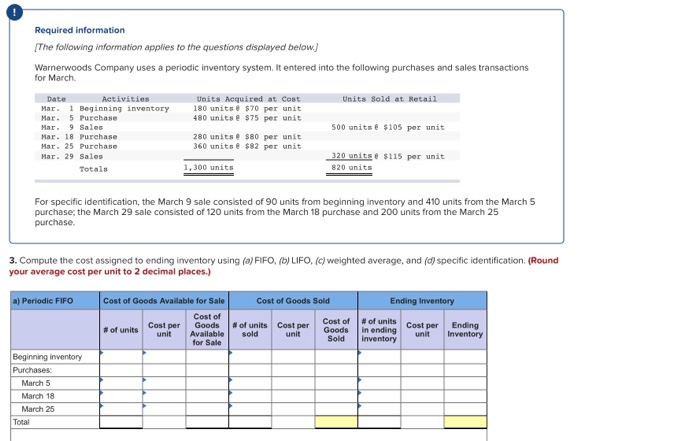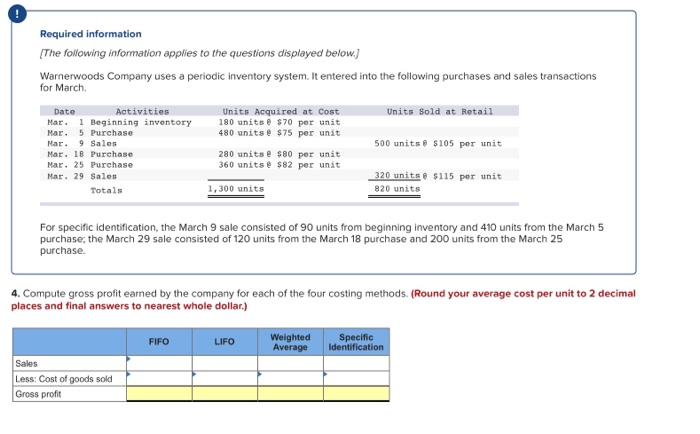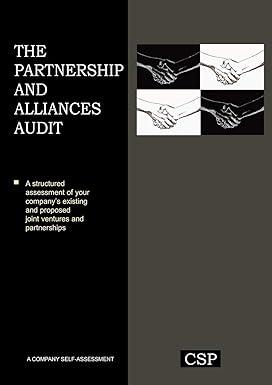Required information The following information applies to the questions displayed below. Warnerwoods Company uses a periodic Inventory system. It entered into the following purchases and sales transactions for March Units Sold at Retail Units Acquired at Cost 180 units@ $70 per unit 480 unitse $75 per unit Date Activities Mar. 1 Beginning inventory Mar. 5 Purchase Mar. 9 Sales Mar. 18 Purchase Mar. 25 Purchase Mar. 29 Sales 500 units @ $105 per unit 280 units $80 per unit 360 units @ $82 per unit $115 per unit 320 units 820 units Totals 1.300 units For specific identification, the March 9 sale consisted of 90 units from beginning inventory and 410 units from the March 5 purchase, the March 29 sale consisted of 120 units from the March 18 purchase and 200 units from the March 25 purchase. 2. Compute the number of units in ending inventory Ending inventory units Required information The following information applies to the questions displayed below) Warnerwoods Company uses a periodic inventory system. It entered into the following purchases and sales transactions for March Units sold at Retail Units Aequired at Cost 180 units $70 per unit 480 units @ $75 per unit 500 units $105 per unit Activities Mar. 1 Beginning inventory Mar. 5 Purchase Mar 9 Sales Mar. 18 Purchase Mar. 25 Purchase Mar. 29 Sales Totals 280 units $80 per unit 360 unitse $82 per unit $115 per unit 320 units 820 units 1.300 units For specific identification, the March 9 sale consisted of 90 units from beginning inventory and 410 units from the March 5 purchase, the March 29 sale consisted of 120 units from the March 18 purchase and 200 units from the March 25 purchase. 3. Compute the cost assigned to ending inventory using () FIFO. (b) LIFO, (c) weighted average, and (d) specific identification (Round your average cost per unit to 2 decimal places.) a) Periodic FIFO Cost of Goods Sold Ending Inventory Cost of Goods Available for Sale Cost of # of units Cost per Goods unit Available for Sale # of units sold Cost per unit Cost of Goods Sold of units in ending Inventory Cost per unit Ending Inventory Beginning inventory Purchases March 5 March 18 March 25 b) Periodic LIFO Cost of Goods Sold Ending Inventory Cost of Goods Available for Sale Cost of Goods # of units unit Available #of units sold Cost per unit Cost of Goods of units in ending inventory Cost per unit Ending Inventory for Sale Sold Beginning inventory Purchases: March 5 March 18 March 25 Total c) Average Cost Cost of Goods Sold Ending Inventory Cost of Goods Available for Sale Cost of Average Goods of units Cost per Available unit #of units Average Caster Unit Cost of #of units Average Goodsin ending Cost per Inventory Ending Sold inventory unit sold for Sale Beginning inventory Purchases: March 5 March 18 March 25 Total d) Specific Identification Cost of Goods Available for Sale Cost of Goods Sold Ending Inventory #of units Cost per Cost of Goods Available for Sale # of units sold Cost per unit Cost of Goods Sold of units in ending Inventory Cost per unit Ending Inventory unit Beginning inventory Purchases: March 5 March 18 March 25 Total Required information The following information applies to the questions displayed below.) Warnerwoods Company uses a periodic inventory system. It entered into the following purchases and sales transactions for March Units Sold at Retail Units Acquired at Cost 180 units @ $70 per unit 480 units $75 per unit 500 units@ $105 per unit Date Activities Mar. 1 Beginning inventory Mar. 5 Purchase Mar. 9 Sales Mar. 18 Purchase Mar. 25 Purchase Mar. 29 Sales Totals 280 units S80 per unit 360 units $82 per unit $115 per unit 320 units 820 units 1.300 units For specific identification, the March 9 sale consisted of 90 units from beginning inventory and 410 units from the March 5 purchase, the March 29 sale consisted of 120 units from the March 18 purchase and 200 units from the March 25 purchase. 4. Compute gross profit earned by the company for each of the four costing methods. (Round your average cost per unit to 2 decimal places and final answers to nearest whole dollar.) FIFO LIFO Weighted Average Specific Identification Sales Less: Cost of goods sold Gross profit










